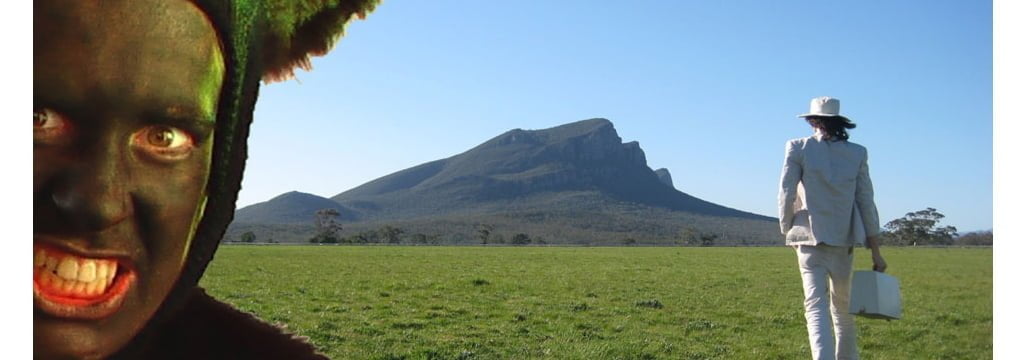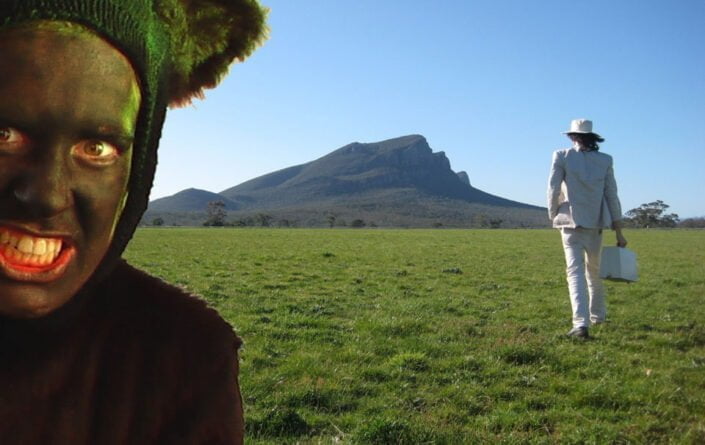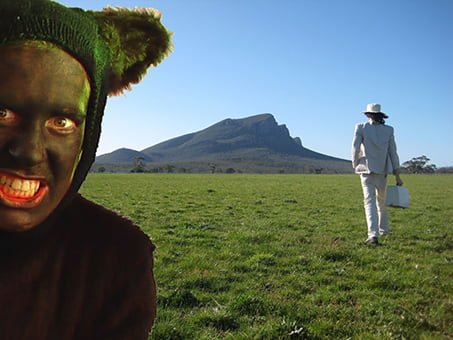Trevor Flinn
Trevor Flinn is a Dunkeld-based artist who makes sculpture and video as a means of investigating legends and to further understand his place in regional Victoria. He wants to tell stories that draw the viewer into a more poetic world – a world of both humour and perversity. After completing a Bachelor of Arts (Art History) Flinn spent about six months overseas. On his return he decided to start making art. It was while studying sculpture at the Victorian College of the Arts (VCA) that he developed a particular interest in installation, video and printmaking.
The series The Puma, the Stranger and the Mountain is an expansive new project, which recreates the local, rural myth of the puma that allegedly stalks the district, terrorising livestock and potentially small children, yet has never been openly sighted. Through Flinn’s re-imagining, the puma myth, shrouded as it is in mystery and ambiguity, turns into an extroverted rock star fantasy. Previously cloaked in anonymity, and with all the solitude that this can bring, the puma succumbs to the lure of fame. Subsequently the band The Meat Eaters is formed, goes on tour and self-destructs. From under the layers of beer cans and cigarette butts, The Meat Eaters find there is no glamour in the phenomenon of being seen for its own sake. The wastelands of popular culture are ever-present on the roads between rural and city locales – and they may initially seem to shorten cultural distances. But in the lust for fame, and the homogenising tendencies of global pop culture, any sense of what is real and unique becomes eternally elusive.
Interview with Trevor Flinn
Trevor Flinn is interviewed by Dunkeld-based journalist and photographer, Pru Saimoun. Dunkeld is located at the southern tip of the Grampians National Park, approximately 250 km west of Melbourne.
Pru Saimoun: Trevor, here we are in the railway station where it all started. What attracted you to the station?
Trevor Flinn: Growing up in Dunkeld, the railway station was always this empty building. After art school I had this romantic idea of having a gallery in Dunkeld and the building just screamed out that it would make a good space. We’ve had four exhibitions so far and it’s taken a year to get to where we are now.
PS: You ended up tying your first exhibition in with another festival?
TF: The Dunkeld Arts Festival seemed like the perfect opportunity to have the opening. I was able to organise a Regional Arts Victoria grant for another artist [Michael Porter] to use the surrounding area, to demonstrate that this area could in the future be a locus of contemporary art in regional Victoria.
PS: So instead of regional artists going into the city, city artists could come and experience regional areas.
TF: That’s right. At the beginning I’d just come back from exhibiting in a show in Melbourne and felt kind of flat after the experience.
PS: So why did you come back?
TF: Over a number of years of study and travelling, I now look at the country as more my home than ever before. It’s come from living in Melbourne and enjoying that lifestyle, but the lifestyle in the country is now what I cherish.
PS: Talking about the importance of community as a young regional artist in establishing your identity and acceptance. How important is that to you?
TF: I think it’s all important. I’ve got certain ties to the town growing up here, and having a community gallery that I’ve been able to facilitate, it somehow justifies my existence in the town. From the beginning when I was talking to locals about using the station as a gallery, I’ve had nothing but positive feedback and when it eventually did happen the community were ready to pitch in and get behind it. That’s the great thing about living in a small community; if you’re able to demonstrate that you can bring something, then the community will support you.
PS: What were you trying to do with your Next Wave exhibition? You focused on the myth of the [Grampians] puma, but you also had the mountain and the stranger.
TF: The title for the exhibition and the idea of the puma came at the same time. Melbourne-based artist Cecilia Fogelberg came to Dunkeld and I saw it as playing out the artist-in-residence thing. You bring someone from the outside into town and they can somehow tell you what your town is. Through Cecilia I was able to look at what Dunkeld is, or how I would explain Dunkeld to an outsider. I took her to various scenic spots, one of them being the Dunkeld cemetery. I thought she might be interested in the grave of the Indian Hawker, Alibuc, whose grave is set way over in the corner. This idea of the stranger I think’s interesting, especially in a small, tight-knit community like Dunkeld. How does a stranger relate to the area?
PS: But in another sense, could that stranger be you within the community, trying to bring your view?
TF: It has crossed my mind. I’m very mindful of living in Dunkeld and not being ‘gainfully’ employed, not having that tie to the land that a lot of people do, who have been here for generations. It was important for me to bring someone to town, and it seems to have been proved by these exhibitions and the fact that our little artist collective has grown up. There was the opportunity to start something like that.
PS: How did you find the community reaction to your exhibition?
TF: It was pretty good, it wasn’t too confronting or unusual for people. There were some paintings by Cecilia and my work was about the puma myth played out with the puma reconfigured as a human. This began through some videos I made dressed as the puma and that evolved into the puma as a rock-star, which was talking about fame and celebrity that seem to be all around us.
PS: Well, I find it really interesting because the legend of the puma is so away from that, he doesn’t want to be famous…
TF: That’s right, it’s this elusive character. To me, that’s the ultimate rock-star figure.
PS: From my point of view, the community reaction to your Next Wave exhibition was fantastic, people loved it. I think they wanted to support you, but they really showed their acceptance of you through your work. I’m wondering how that went in Melbourne? What reaction did you get outside your community?
TF: The part of the exhibition that was most successful was the video pieces. People seemed to stay with the video and laugh, so the element of humour translated. One time there was a homeless man and he was completely transfixed by the video, he was watching it and laughing and he seemed to really get a kick out of it. That was the best kind of outcome of the whole thing.
February 2009Trevor Flinn is a Dunkeld-based artist who makes sculpture and video as a means of investigating legends and to further understand his place in regional Victoria. He wants to tell stories that draw the viewer into a more poetic world – a world of both humour and perversity. After completing a Bachelor of Arts (Art History) Flinn spent about six months overseas. On his return he decided to start making art. It was while studying sculpture at the Victorian College of the Arts (VCA) that he developed a particular interest in installation, video and printmaking.
The series The Puma, the Stranger and the Mountain is an expansive new project, which recreates the local, rural myth of the puma that allegedly stalks the district, terrorising livestock and potentially small children, yet has never been openly sighted. Through Flinn’s re-imagining, the puma myth, shrouded as it is in mystery and ambiguity, turns into an extroverted rock star fantasy. Previously cloaked in anonymity, and with all the solitude that this can bring, the puma succumbs to the lure of fame. Subsequently the band The Meat Eaters is formed, goes on tour and self-destructs. From under the layers of beer cans and cigarette butts, The Meat Eaters find there is no glamour in the phenomenon of being seen for its own sake. The wastelands of popular culture are ever-present on the roads between rural and city locales – and they may initially seem to shorten cultural distances. But in the lust for fame, and the homogenising tendencies of global pop culture, any sense of what is real and unique becomes eternally elusive.
Interview with Trevor Flinn
Trevor Flinn is interviewed by Dunkeld-based journalist and photographer, Pru Saimoun. Dunkeld is located at the southern tip of the Grampians National Park, approximately 250 km west of Melbourne.
Pru Saimoun: Trevor, here we are in the railway station where it all started. What attracted you to the station?
Trevor Flinn: Growing up in Dunkeld, the railway station was always this empty building. After art school I had this romantic idea of having a gallery in Dunkeld and the building just screamed out that it would make a good space. We’ve had four exhibitions so far and it’s taken a year to get to where we are now.
PS: You ended up tying your first exhibition in with another festival?
TF: The Dunkeld Arts Festival seemed like the perfect opportunity to have the opening. I was able to organise a Regional Arts Victoria grant for another artist [Michael Porter] to use the surrounding area, to demonstrate that this area could in the future be a locus of contemporary art in regional Victoria.
PS: So instead of regional artists going into the city, city artists could come and experience regional areas.
TF: That’s right. At the beginning I’d just come back from exhibiting in a show in Melbourne and felt kind of flat after the experience.
PS: So why did you come back?
TF: Over a number of years of study and travelling, I now look at the country as more my home than ever before. It’s come from living in Melbourne and enjoying that lifestyle, but the lifestyle in the country is now what I cherish.
PS: Talking about the importance of community as a young regional artist in establishing your identity and acceptance. How important is that to you?
TF: I think it’s all important. I’ve got certain ties to the town growing up here, and having a community gallery that I’ve been able to facilitate, it somehow justifies my existence in the town. From the beginning when I was talking to locals about using the station as a gallery, I’ve had nothing but positive feedback and when it eventually did happen the community were ready to pitch in and get behind it. That’s the great thing about living in a small community; if you’re able to demonstrate that you can bring something, then the community will support you.
PS: What were you trying to do with your Next Wave exhibition? You focused on the myth of the [Grampians] puma, but you also had the mountain and the stranger.
TF: The title for the exhibition and the idea of the puma came at the same time. Melbourne-based artist Cecilia Fogelberg came to Dunkeld and I saw it as playing out the artist-in-residence thing. You bring someone from the outside into town and they can somehow tell you what your town is. Through Cecilia I was able to look at what Dunkeld is, or how I would explain Dunkeld to an outsider. I took her to various scenic spots, one of them being the Dunkeld cemetery. I thought she might be interested in the grave of the Indian Hawker, Alibuc, whose grave is set way over in the corner. This idea of the stranger I think’s interesting, especially in a small, tight-knit community like Dunkeld. How does a stranger relate to the area?
PS: But in another sense, could that stranger be you within the community, trying to bring your view?
TF: It has crossed my mind. I’m very mindful of living in Dunkeld and not being ‘gainfully’ employed, not having that tie to the land that a lot of people do, who have been here for generations. It was important for me to bring someone to town, and it seems to have been proved by these exhibitions and the fact that our little artist collective has grown up. There was the opportunity to start something like that.
PS: How did you find the community reaction to your exhibition?
TF: It was pretty good, it wasn’t too confronting or unusual for people. There were some paintings by Cecilia and my work was about the puma myth played out with the puma reconfigured as a human. This began through some videos I made dressed as the puma and that evolved into the puma as a rock-star, which was talking about fame and celebrity that seem to be all around us.
PS: Well, I find it really interesting because the legend of the puma is so away from that, he doesn’t want to be famous…
TF: That’s right, it’s this elusive character. To me, that’s the ultimate rock-star figure.
PS: From my point of view, the community reaction to your Next Wave exhibition was fantastic, people loved it. I think they wanted to support you, but they really showed their acceptance of you through your work. I’m wondering how that went in Melbourne? What reaction did you get outside your community?
TF: The part of the exhibition that was most successful was the video pieces. People seemed to stay with the video and laugh, so the element of humour translated. One time there was a homeless man and he was completely transfixed by the video, he was watching it and laughing and he seemed to really get a kick out of it. That was the best kind of outcome of the whole thing.
February 2009



